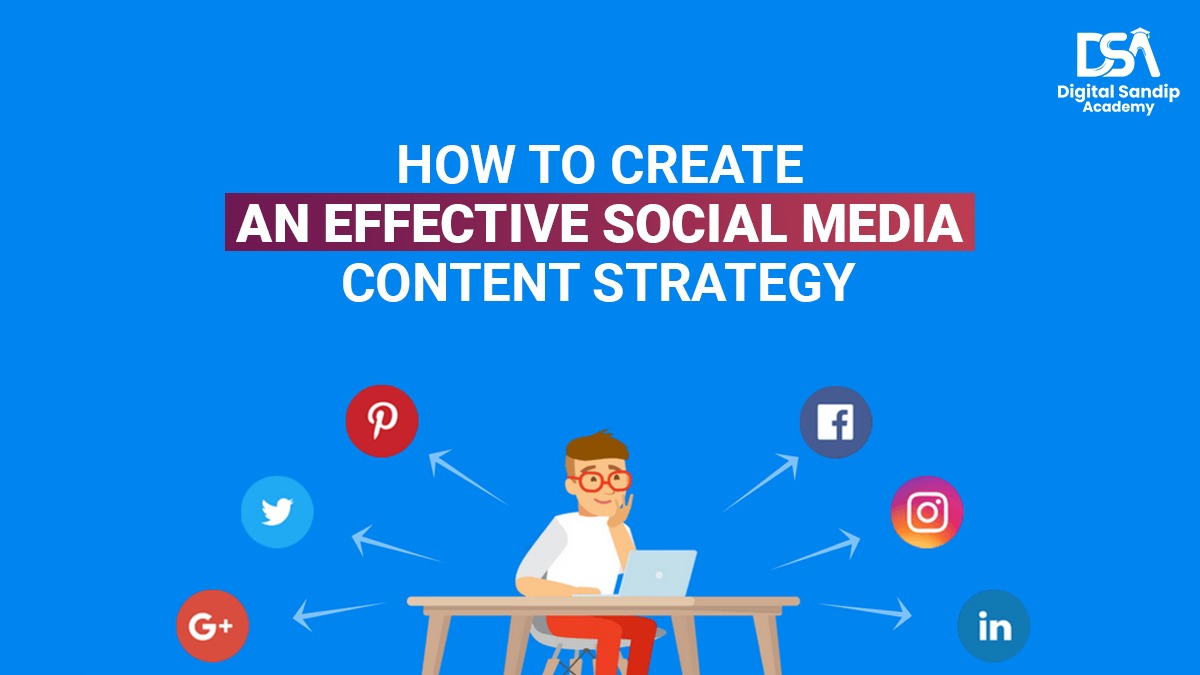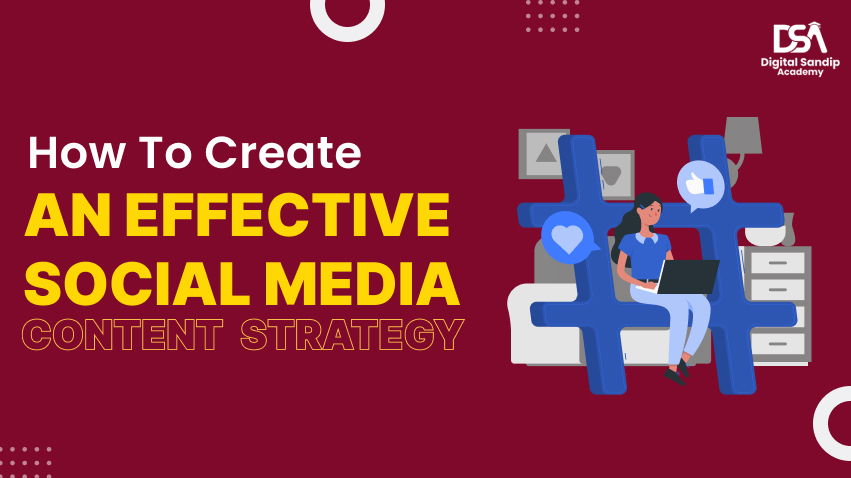What is Social Media Content?
Social media content is created by an organization or an individual for various social media channels like Facebook, Instagram, or Twitter. Such social media channels provide companies with an excellent opportunity to have a more direct conversation with the users than classic marketing measures. In short social media strategy can be treated as a blueprint for the business’s success across social platforms. Without a solid strategy, the company’s social media efforts will lack direction and expected results won’t be delivered. Dedicated time and resources are needed to chart out what the business wants to achieve, how to achieve it, and how to measure the impacts that the company’s effort will have on the goals.
Although it is not easy for any person or organization to start building a strategy, this blog would most certainly help the readers prepare the social media content strategy from the scratch.
Digital Sandip Academy
If you want to look for a social media content strategy in Digital Marketing in India, then you should check out the Digital Sandip Academy which is India’s No. 1 Digital Marketing Agency.
Digital Sandip Academy is the best Academy to learn Online Digital Marketing Courses.
Digital Sandip Academy is providing the best Online Digital Marketing Course in Ahmedabad. Apart from digital marketing services, they also provide internships, and live projects to their students and helping students to start their own start-ups and building their profiles.

Get in touch with Digital Sandip Academy to access Digital Marketing advance Courses, PPC course, SEO training, Social media training, Email marketing, Inbound marketing, Google Tag Manager, Google Analytics training, and many more.
The Digital Sandip Academy is led by Mr. Sandip Trivedi, who is the founder and CEO of the academy. With 10+yrs of experience and having trained 50,000+ students. He has extensive experience in this industry both as a leading digital marketing consultant and as a trainer. He aims to create a more talented resource in the domains of Digital Marketing, Digital Analytics, and Digital Research.
Digital Sandip Academy provides advanced digital marketing courses that cover the following services:
- Digital Marketing
- Search Engine Optimization
- Facebook Marketing
- Google Analytics
- Lead Generation
- Inbound marketing
- WordPress website development
- Youtube SEO
- SEM
- SMM(Social Media Marketing)
- Email marketing
- Web Analytics
- Landing Page Design Course
- Google Tag Manager
Address: A-206, Addor Ambition, Beside Vimal House, Near Navkar Classes, Navrang Circle, Navrangpura, Ahmedabad.
Email: [email protected]
Website: https://www.digitalsandipacademy.com/
Contact No: +91-7567154257
Why Social Media Content Strategy?
The preliminary step for a long social media strategy is to set your content goals. The user has to figure out what and how they want to achieve those goals. This process involves prodding deep into the brand values as well as researching the audience. When the brand crafts a strategy to meet its goals, the chance of successfully achieving them increases on an enormous scale.
The strategy helps the brand to be a stand out in social media channels by identifying specific goals, creating valuable posts that align with those goals, and distributing content on the right platforms. This will help the brand measure the results and fine-tune its strategy over time.
Identify & Create Goals
Creating goals will help the company churn out the plan on selecting the type of content that is created. Goals and KPI’s are the parameters of measuring the success of the brand’s efforts. Setting goals allows the brand to determine its social strategy’s ROI. One can follow the S.M.A.R.T approach to establish a better strategic plan.
- Specific (Goals should be comprehensible and specific to allow a logical focus on what needs to be achieved)
- Measurable (Must be able to measure the progress of goals to know when the brand achieved them)
- Attainable (Goals should be sensible, yet should be challenging enough to motivate the organization)
- Relevant (Goals should be pertinent to your wider business objectives and make sense when achieved)
- Time-bound (Brand should always set a timeframe for goals to be measured to maintain focus)
Hence, it’s important to start with the social media content strategy with goal-setting to serve the business goals.
Understand The Audience & Plan The Social Content Accordingly
It’s important to understand the audience in order to tailor the content to improve brand awareness and create new followers. Taking a selective approach is way more effective than trying to capture a wider audience with a single strategy.
Knowing the active audience can drastically help the brand to generate an increased level of engagement by sharing the content at right time and to the right audience, by simply investing in the right tools to gain insights through different social media channels.
Some posts serve the business to meet bigger marketing goals. But even promotional content should be on brand and true to their nature as your audience began following you for a reason. Following the original and unique style and creating content accordingly is what allows the brand to be a standout. Brands having a consistent approach will help them have a better understanding of who their audience is and what are their expectations from your brand.
A brand should also take a keen note of which platforms their content succeeds most on while doing the diligent research part, as it is impractical to expect to perform well on all of them. Hence smartly allocating the resources of the company to the platforms that serve their brand and the audience is needful.
Focusing on The Right Social Media Platform
As mentioned before, the company needs to focus on the right social media platform where their audience is active and is most likely to engage with the brand, rather than spreading the time and content too thinly across every accessible platform.
Let’s look at some general approach guideline for different types of social media platforms:–
Facebook– It’s effective for both B2B and B2C businesses, with support for a whole bunch of different content formats, ad targeting options, and users.
Twitter – Due to the platform’s fast-moving nature and the fact that it is still very much based around a simple Tweet format, it is not for every type of business.
LinkedIn – It can be termed as the best social media platform for B2B service businesses and is the perfect place to position individuals and companies as specialists through a content strategy based on leadership and a strong focus on informative content.
Pinterest – It is a favorite amongst eCommerce retailers and owners of businesses that can be easily advocated visually.
YouTube – Being the world’s second-largest search engine, pretty much all sectors can benefit from the platform. However, businesses need to be prepared to consistently publish engaging video content.
Instagram– Most often the first or second-choice platform for B2C businesses that have access to engaging photos and images and engage their audience. It is usually trivial to B2B businesses.
Plan Social Content
After finalizing the social content and the social media channel platform, the organization needs to plan out its content and the formats that are going to create a buzz. The beginning point is to map out the key messages that the brand wants to share with its audience. There is a need to balance different formats to ensure the brand is getting its key message across effectively, and some of them include, User-generated content, Live streams, Contests & competitions, Case studies, Influencer marketing collaborations.
It is important to not rely on a single content format if a brand truly wants to drive engagement with its audience. Posting the same content may be interpreted as inauthentic or irrelevant, causing a decrease in engagement with the audience. Irrelevant posts are the second biggest reason for consumers to be driven away from brands on social media.
Establish A Content Calendar
After identifying the primary goals and the content that performs the best, the company should focus on building a social media content calendar. A calendar will let the business take a big-picture approach to social media content planning. It will help them envision their ideas and organize them in a way that makes the strategy facile to execute. Most importantly it will make the user more accountable.
When the user is planning content, he or she should not be afraid to reuse content and schedule it across different social media platforms to get the most out of it.
The content calendar also helps the user work with other teams to complete goals. Any strategy will involve cooperating knowledge of a lot of different people within your organization. For example, if a brand has 3 weeks to launch a new campaign, their content team, and graphics teams can both view the calendar and ensure tasks are done on time.
Social media schedule:-
- Facebook: 5 to 7 posts per week
- Twitter: 3 to 5 Tweets per day
- LinkedIn: 1 post per day
- Instagram: 1 post or story per day
- Pinterest: Focus on creating interesting boards and sharing relevant images rather than a set posting schedule
Publishing of Content
Publishing and promoting content is a time-consuming process hence a good strategy involves finding ways to actively distribute your content so that as many people as possible see it. When a company establishes a content distribution strategy, they’ll set up their posts to be shared more widely.
A brand should actively put out blogs include share buttons on their posts so their audience can further distribute the content to their followers. The company can also motivate its audience to engage with the content by asking a question and encouraging the audience to share their answers, on social media or in the comments section of a blog post.
Other people publishing the brand content are excellent social proof as well. Platforms like Twitter and Instagram, utilize hashtags. Hashtags help the brand reach people who not only follow them but are following a specific trend or interest.
Another rectitude publishing strategy involves networking with bloggers and content creators with your brand.
Measure Performance
The final stage to an effective social media content strategy is measuring the results of all of the brand efforts. The company needs to track its performance with the previously established goals in order to measure their performances.
Proper tracking is always going to be essential for creating a strategy with durability. Ideally, it’s recommended to track and analyze the content every month to keep track of what’s working.
When a company analyses the data, they should take a top-level view of their content over a given period of time. Assessing how each block of content performed and what variables it had working with it. It establishes how well the content contributed to the overall content goals that the business set in step one.
Conclusion
It’s important for any business or company to not neglect the power of putting together a rigid social content strategy. Effectively planning a social media content strategy is a continuous cycle. It’s a road map for a brand’s success, and a clear plan of action that can be communicated across all the team members and key stakeholders across the organization and the resources and time put together in order to achieve the goals.








